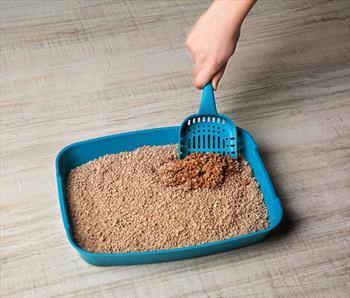Cleaning dirty litterbox

Scooping litterboxes regularly is good for your cat and your household.
What Causes House Soiling in Cats?
A cat’s use of locations other than the litter box to deposit urine, feces, or both comes under many names including house soiling, inappropriate urination/defecation, and spraying. Your cat is not acting out or angry with you. Cats don't think that way. Cats go in places outside of the box because something is wrong. It could be their health, problems with another cat, problems with the litter box, the list is long.
Consult your veterinarian immediately if house soiling starts to make sure your cat does not have a medical issue. There are many medical causes of house soiling, and some, such as urinary tract blockage, pose an immediate threat to your cat's life. Waiting to see what happens could mean unnecessary suffering for your cat.
Once your veterinarian assesses your cat's health, discussion about diets, environmental needs, and behavioral concerns can follow. Many times, your veterinarian will identify more than one problem, including medical, environmentak, and behavioral concerns. They are there to work with you and your cat to resolve these concerns.
Litter Box Care
Location Location Location
Provide more than one location in the household for litter boxes. Consider having one on each floor if space allows. Avoid moving boxes around.
Depth Matters
Experiment with different depths of litter. Most cats prefer 1—1.5 inch depth while others may prefer deeper litter.
Negative Associations
Keep litter boxes away from rooms that contain noisy equipment such as furnaces or washing machines. The noises may frighten your cat. Avoid administering medications or doing anything unpleasant to your cat while they are in the litter box or litter box area.
Don’t Soil Where You Eat
Keep food and water dishes in a separate room or more than 5 feet away from the litter boxes.
Depositphotos_483878096_M.jpg - Caption. [Optional]
![Depositphotos_483878096_M.jpg - Caption. [Optional] Brown and black cat in pink litterbox](/AppUtil/Image/handler.ashx?imgid=8038980&w=300&h=429)
Litter Box 'Cafeteria'
If you need to assess your cat’s preferences (e.g. litter type, box type, litter depth), add a litter box with the new option. It is tempting to change the existing litter box, but your cat may not like the new option, so add a box with the new option instead. Take note of which litter boxes get used the most and make that the standard for the majority of the boxes.
Litter Box Criteria
Number of Boxes
Provide one litter box per household cat plus one additional box. For example, a household with three cats should have four litter boxes. These should be in multiple locations throughout the home, not side by side or in the same room.
Litter Type: Clay or Other?
While some cats will tolerate some of the newer types of litter (corn, wheat, etc.), given options, these other litter types may not be the cat’s preference. Offer the new litter as an option to determine your cat’s preference.
Scented or Unscented
Use unscented clumping litter. Most cats prefer this texture best next to sandbox sand. Scented litters are too strong-smelling for cats. The scent can impact the cat’s sense of safety at home, preventing them from using their sense of smell to check for dangers such as predators.
Size Matters
Provide large size litter boxes that are 1.5 times the length of your cat (tip of nose to base of tail). Many litter boxes are simply too small! Older cats with arthritis need boxes with low walls or a low door cut in the box. Climbing over the high walls may be painful.
Keep it Open
Most cats do not feel comfortable in a covered box as there is no easy escape route. If you are unsure of your cat’s preference, offer both options and see which box your cat uses most.
Keep it Clean
Scoop litter one to twice daily. More often is best. Empty out the litter tray once every 1—2 weeks. Clean the litter box with a mild detergent, rinse well, and dry well before adding new litter.